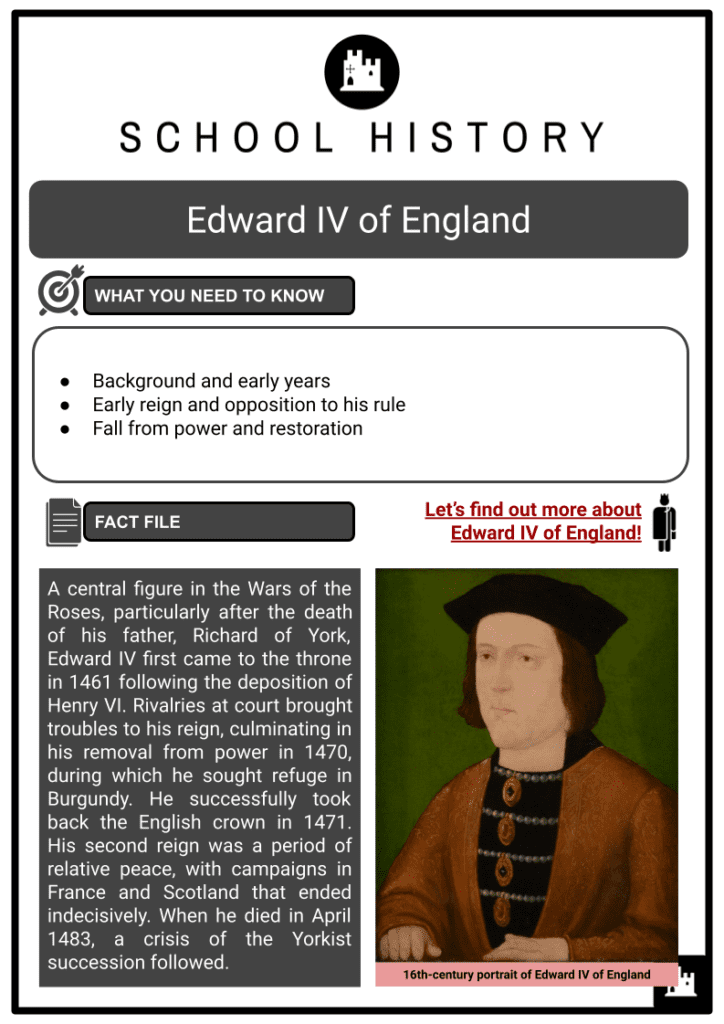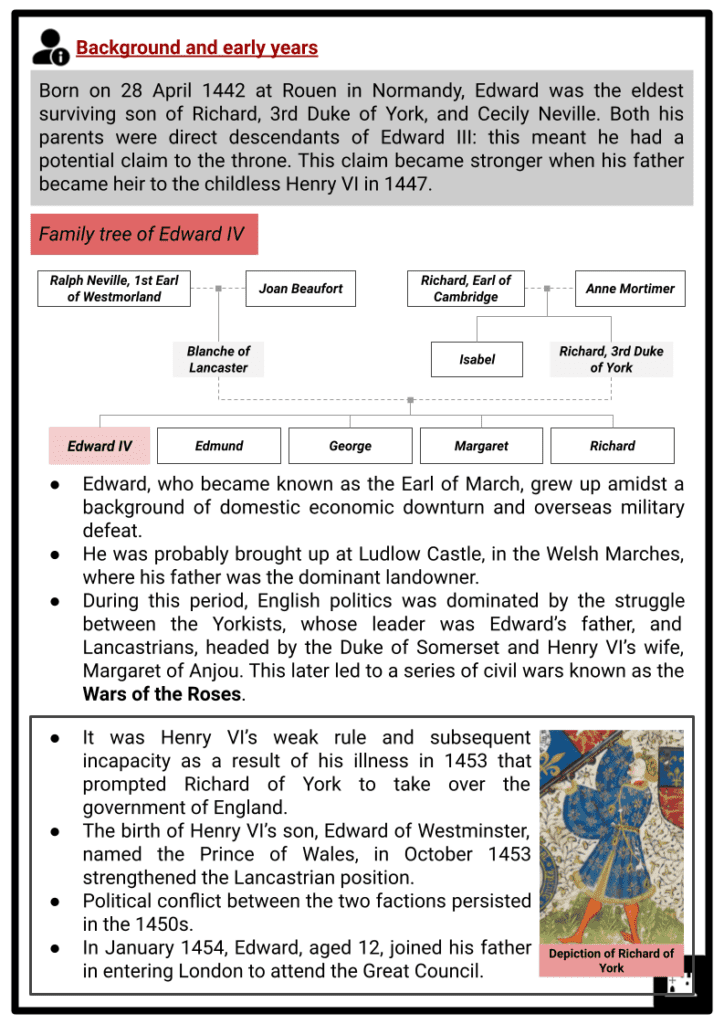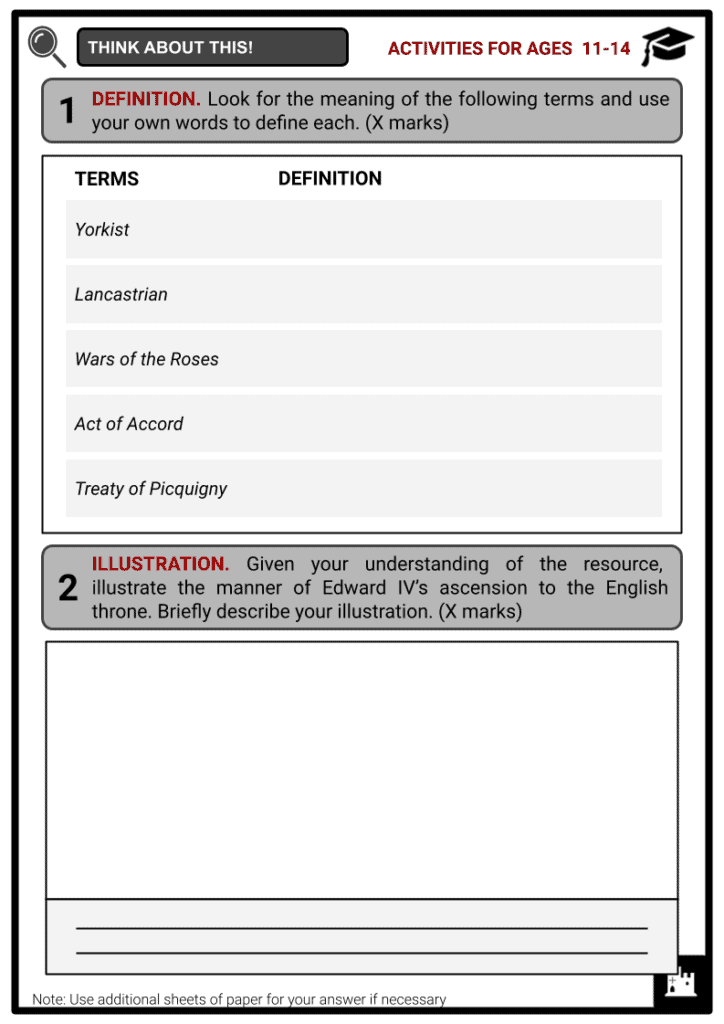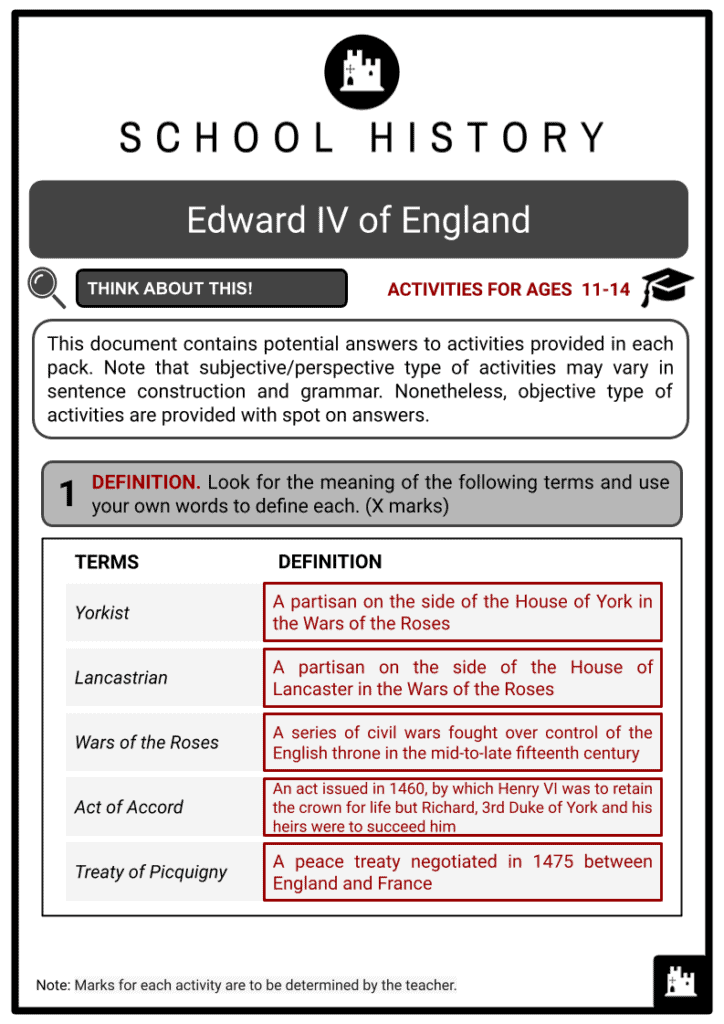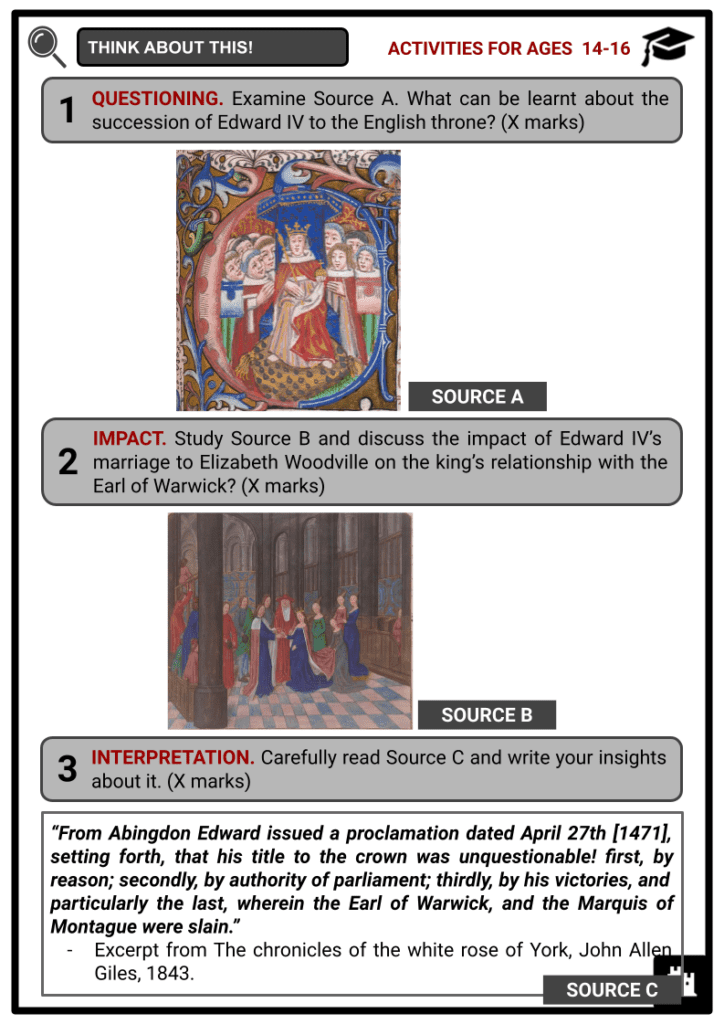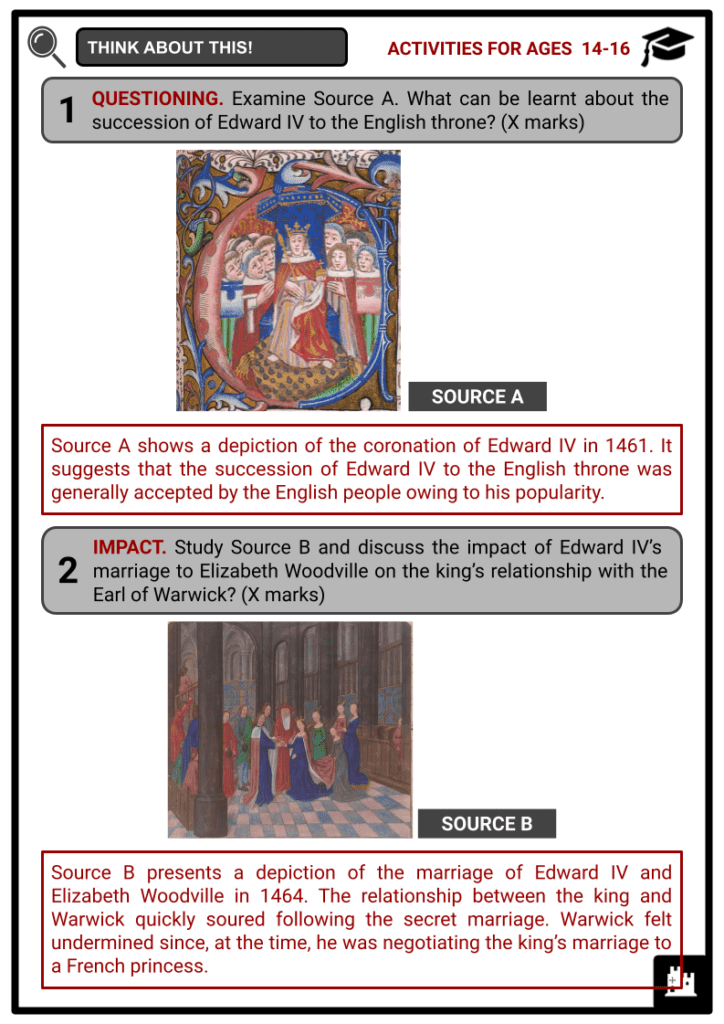Edward IV of England Worksheets
Do you want to save dozens of hours in time? Get your evenings and weekends back? Be able to teach about Edward IV of England to your students?
Our worksheet bundle includes a fact file and printable worksheets and student activities. Perfect for both the classroom and homeschooling!
Summary
- Background and early years
- Early reign and opposition to his rule
- Fall from power and restoration
Key Facts And Information
Let’s find out more about Edward IV of England!
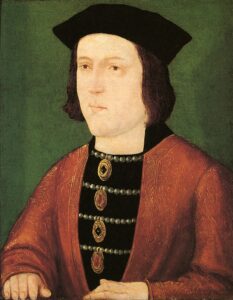
A central figure in the Wars of the Roses, particularly after the death of his father, Richard of York, Edward IV first came to the throne in 1461 following the deposition of Henry VI. Rivalries at court brought troubles to his reign, culminating in his removal from power in 1470, during which he sought refuge in Burgundy. He successfully took back the English crown in 1471. His second reign was a period of relative peace, with campaigns in France and Scotland that ended indecisively. When he died in April 1483, a crisis of the Yorkist succession followed.
Background and early years
- Born on 28 April 1442 at Rouen in Normandy, Edward was the eldest surviving son of Richard, 3rd Duke of York, and Cecily Neville. Both his parents were direct descendants of Edward III: this meant he had a potential claim to the throne. This claim became stronger when his father became heir to the childless Henry VI in 1447.
- Edward, who became known as the Earl of March, grew up amidst a background of domestic economic downturn and overseas military defeat.
- He was probably brought up at Ludlow Castle, in the Welsh Marches, where his father was the dominant landowner.
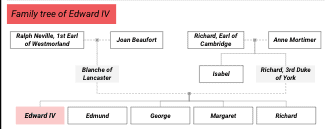
- During this period, English politics was dominated by the struggle between the Yorkists, whose leader was Edward’s father, and Lancastrians, headed by the Duke of Somerset and Henry VI’s wife, Margaret of Anjou. This later led to a series of civil wars known as the Wars of the Roses.
- It was Henry VI’s weak rule and subsequent incapacity as a result of his illness in 1453 that prompted Richard of York to take over the government of England.
- The birth of Henry VI’s son, Edward of Westminster, named the Prince of Wales, in October 1453 strengthened the Lancastrian position.
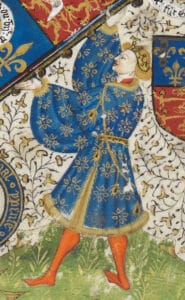
Depiction of Richard of York - Political conflict between the two factions persisted in the 1450s.
- In January 1454, Edward, aged 12, joined his father in entering London to attend the Great Council.
- By the age of 17, Edward proved to be an experienced political and military leader.
- Hostilities between the Yorkists and Lancastrians reopened in 1459. Following the defeat at the Battle of Ludford Bridge, he, along with the Earls of Salisbury and Warwick, made their way to Calais whilst his father and brother Edmund escaped to Ireland.
- In 1460, Edward crossed the English Channel and marched into London.
- At the Battle of Northampton, he commanded one of three divisions in a Yorkist victory that led to the capture of Henry VI.
- Following the Lancastrian defeat at Blore Heath, York crossed from Ireland to England and acted like a king as he approached London.
- Whilst the parliament had expressed their support for the Yorkist cause, York’s actions were not well received, neither by the nobles nor by his supporter Warwick.
- He continued fighting for his claim to the crown and produced genealogies to support this.
- Negotiation dragged on for weeks until an agreement was achieved through a statute of parliament.
- Under the terms of the Act of Accord (1460), Henry VI was to remain king for the remainder of his life, but after his death the throne was to pass to Richard of York and his heirs rather than to Henry VI’s heirs.
- This resulted in a significant opposition to the Yorkist administration.
- In late 1460, Edward was given his first independent command and sent to deal with a Lancastrian insurgency in Wales.
- Meanwhile, Margaret of Anjou, who strongly opposed the endorsement of York as the king’s heir, began assembling a Lancastrian army at Pontefract Castle and targeted the estates of York and other prominent Yorkists in the north of England.
- York, along with his son Edmund and Salisbury, marched north from London and gathered an army.
- The Yorkist defeat at the Battle of Wakefield led to the death of York, Edmund and Salisbury, which left Edward assuming both the mantle as Duke of York and the attempt to claim the throne.
- After learning that a Lancastrian army had landed in south-west Wales, Edward advanced to meet them at the Battle of Mortimer’s Cross on 2 February 1461 and decisively defeated the Welsh Lancastrians.
- At the Second Battle of St Albans, Warwick and his troops were forced to withdraw and the Lancastrians regained custody of Henry VI.
- Warwick and Edward met in London, where the latter was hastily crowned king, before marching north to meet Margaret of Anjou’s army at Towton.
- The Battle of Towton, notable for its huge number of deaths, proved to be a decisive victory for the Yorkists.
- Henry VI and Margaret, along with Prince Edward, had sought sanctuary in Scotland and stayed there for the next three years. The Lancastrian cause was far from over.
Early reign and opposition to his rule
- Edward IV, aged 20, proceeded to London for his coronation as King, which occurred on 28 June 1461. By October that year, the consolidation of Edward IV’s authority in the north of England was fully achieved by Warwick, who returned to Westminster to join the new king. For his services in rallying for Edward IV, Warwick was greatly rewarded.
- Lancastrian opposition in the North continued during the first years of Edward IV’s reign.
- Whilst Edward IV did not personally participate in the campaigns, and instead left it to his captains, Warwick and John Neville, 1st Marquess of Montagu, he made frequent progresses and took some part in the fighting during 1462 and 1463.
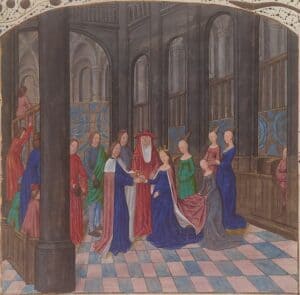
Illuminated miniature depicting the marriage of Edward IV and Elizabeth Woodville - The king was absent during Lord Montagu’s decisive victory at the 1464 Battle of Hexham, because at the time, he was engaged in contracting a secret marriage with Elizabeth, daughter of Richard Woodville, Earl Rivers.
- When the marriage of Edward IV and Elizabeth Woodville was disclosed, Warwick was enraged since, at the time, he was negotiating the king’s marriage to a French princess.
- This brought to light internal divisions over foreign policy, particularly the relationship between England, France and the Duchy of Burgundy.
- The established nobility at court as well as the Privy Council resented the marriage, which was thought to be unwise and unusual.
- The marriage had significant political implications that impacted the rest of Edward IV’s reign as it allowed for the rise of the Woodvilles at court.
- Whilst the king initially limited grants of lands and offices to the Woodvilles upon the marriage, they eventually gained enormous influence as advantageous marriages were found for Elizabeth’s siblings.
- In addition, Edward IV began to rely on his father-in-law, Earl Rivers. On the other hand, Warwick appeared less and less in court.
- Warwick saw his political power collapsing but there was no open breach until 1469, when he, backed by the king’s brother George, Duke of Clarence, took advantage of the unpopularity of the Woodvilles, and appeared in arms and clashed with the royal army at the Battle of Edgecote Moor.
- Edward IV was captured and imprisoned at Warwick Castle for several months whilst Earl Rivers and his sons were beheaded at Kenilworth.
- Edward IV was able to escape imprisonment and regain control of the country with the help of Richard, Duke of Gloucester. Warwick’s actions did not impress the nobility, thus he failed to regain his political power at court. An opportunity rose in early 1470. Warwick and Clarence instigated a rebellion that led to the Battle of Losecoat Field. The royal army suppressed the rebels, and evidence that Warwick and Clarence were complicit in the rebellion was found. As a result, the two fled to France and defected to the Lancastrian cause, forging an unlikely arrangement with Margaret of Anjou.
Fall from power and restoration
- Now allied to the French and Lancastrians, Warwick landed in England in September 1470. Many Lancastrian nobles and supporters joined him in replacing Edward IV with Henry VI. Edward IV was forced to flee to Burgundy, hence Henry VI was reinstated as a puppet king ruling through Warwick.
- Edward IV took refuge in Flanders, which was part of the duchy ruled by Charles the Bold, husband of his sister Margaret.
- The reinstated Lancastrian rule encountered the same issue that prevailed in Henry VI’s reign.
- In April 1471, Edward IV, aided by wealthy Flemish merchants, returned to England to take back the English throne.
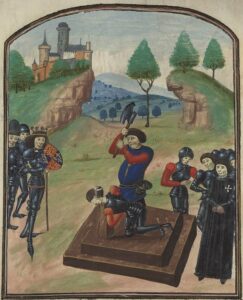
Depiction of Edward IV watching the execution of Somerset - As Edward IV marched from York to Nottingham, supporters, who were initially reluctant, began to join him.
- He entered London unopposed and took Henry VI prisoner.
- Meanwhile, Warwick was defeated and killed at the Battle of Barnet whilst another Lancastrian force was destroyed at the Battle of Tewkesbury.
- Henry VI’s son and heir, Edward of Westminster, died on the battlefield, whilst surviving leaders like Somerset were executed thereafter.
- Henry VI met his death in the Tower of London on 21 May 1471, probably on orders from Edward IV.
- Margaret of Anjou was imprisoned first at Wallingford Castle and later at the more secure Tower of London.
- Following the resounding victories at Barnet and Tewkesbury, Edward IV was restored to the English throne in 1471.
- Having restored a sense of order to England, his second reign was a period of relative peace and security thanks to his management of government.
- The birth of his son in 1470 during his exile was advantageous to his position, as well as the confiscation of the estates of his opponents.
- The only serious endeavour of Edward IV’s latter reign was the revival of the project of an invasion of France.
- Edward IV made great preparations with Burgundy and was later joined by Brittany in 1475.
- Despite these impressive preparations enabled by a huge grant from parliament, the actual campaigning was poor and received little assistance from Burgundy.
- This forced Edward IV to agree to the Treaty of Picquigny after his large force landed at Calais.
- The treaty stipulated a ten-year truce between France and England and provided Edward IV with money for home government.
- The regime was also destabilised by an ongoing conflict between Clarence and Gloucester.
- The two were married to the Nevilles, and hence claimed a share in the Neville inheritance.
- This rivalry and Clarence’s continued intrigues led Edward IV to believe that Clarence was aiming at his throne.
- In 1477, Clarence was summoned to Windsor and accused of treason. The king presented the charges against his brother to parliament.
- Both houses of parliament passed the bill of attainder and the sentence of death for Clarence. Clarence was privately executed at the Tower in 1478, ending the king’s domestic trouble.
- In 1482, Edward IV backed an invasion of Scotland, sending his brother Gloucester to lead an army that would replace James III of Scotland with Alexander Stewart, Duke of Albany.
- The campaigning was successful with the Scottish king captured.
- However, Albany renounced his claim and restored James III to the throne. Edward IV then ordered Gloucester to withdraw from Edinburgh and Scotland.
- The health of Edward IV began to fail and in 1483, he fell fatally ill. He died at Windsor Castle on 9 April that same year. He was survived by his wife, two sons and five daughters. His twelve-year-old son and heir, Edward V, was never crowned, Gloucester becoming Richard III in July.
Image Sources
- https://en.wikipedia.org/wiki/Edward_IV_of_England
- https://upload.wikimedia.org/wikipedia/commons/d/dc/Richard_of_York_Talbot_Shrewsbury_Book.jpeg
- https://upload.wikimedia.org/wikipedia/commons/thumb/3/33/Marriage_Edward_IV_Elizabeth_Woodville_miniature_Wavrin_Anciennes_Chroniques_d%27Angleterre_Francais_85_f109.jpeg/610px-Marriage_Edward_IV_Elizabeth_Woodville_miniature_Wavrin_Anciennes_Chroniques_d%27Angleterre_Francais_85_f109.jpeg?20160516111558
- https://upload.wikimedia.org/wikipedia/commons/thumb/f/fc/Beheading_duke_somerset.jpg/800px-Beheading_duke_somerset.jpg

